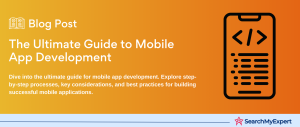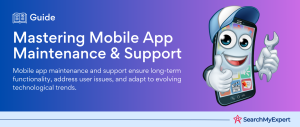We recognize the importance of KPIs in the realm of app development. To achieve a successful app, it’s not just about building and launching. The true measure of success is the ability to drive results post-launch. Let’s delve deep into the critical KPIs that can make or break the success of your mobile application.
1. Performance Metrics: The Backbone of App Success
Apps today thrive on speed and efficiency. If they falter in performance, they risk losing their user base.
App Latency and API Latency
High-speed response is the name of the game. Users expect instantaneous reactions to their actions. App latency and API latency measure the time it takes for an app to respond to user requests and for an API to complete its functions, respectively. The golden standard? A response time of just one second.
Network Errors
An app’s reliance on network services means it’s susceptible to network errors. These can arise from HTTP issues or complications at the service provider’s end, leading to reduced responsiveness and the dreaded app crashes.
App Crashes
Every developer’s nemesis, app crashes can tarnish an app’s reputation. While the average crash rate hovers around 1-2%, it’s essential to understand the nuances, as this rate can vary based on the app’s type, size, and functionality.
App Load Per Session
This metric underscores an app’s performance under varying loads. It’s gauged by the number of calls or transactions over a specific timeframe. An app’s resilience to sudden load changes can mean the difference between soaring and plummeting download numbers.
2. User Metrics: Understanding Your Audience
Every app is crafted with a user in mind. Grasping user behavior, demographics, and preferences is pivotal.
Geographical Metrics
Apps often target specific regions, countries, or states. Geographical data sheds light on where your app shines and where it might need tweaking.
OS and Device Metrics
In our diverse digital landscape, apps must perform seamlessly across multiple operating systems and devices. This metric is a beacon for developers, highlighting areas for improvement specific to certain devices or OS.
Active User Count
An app’s pulse can be felt by its daily and monthly active users. This metric paints a clear picture of user engagement, helping developers pivot their strategies to keep users hooked.
3. Engagement Metrics: Fostering User Connections
User engagement is the heart and soul of an app. It’s the bridge between mere downloads and active, loyal users.
Session Length
This metric speaks volumes about user engagement. It measures the time from when a user opens the app to when they close it. It provides invaluable insights into which app elements resonate with users.
Interval Between Sessions
How often users return to your app is a testament to its value. Tracking the time between sessions can offer a window into user behavior and app utility.
Retention Rate
It’s one thing to download an app; it’s another to use it consistently. The retention rate gives a clear picture of an app’s stickiness, guiding developers on feature enhancement and user targeting.
4. Business Metrics: The Bottom Line
At the end of the day, apps aim to drive revenue and profit. Business metrics are the compass guiding developers towards financial success.
Acquisition Cost
Users discover apps through various channels. Understanding the most effective channels can streamline marketing efforts and optimize user acquisition costs.
Abandonment Rate
Transactions don’t always reach the finish line. By pinpointing why users abandon transactions, developers can refine the user experience and boost completion rates.
Transaction Revenue
For transaction-based apps, this metric is gold. It reveals which features or services are generating the most revenue, guiding future development and enhancement efforts.
Lifetime Value
An app’s worth isn’t just its current revenue. Lifetime value encapsulates everything from user base and ratings to revenue generation and overall income, offering a holistic view of an app’s success.
A Note on Ratings
While many KPIs steer the course of an app, ratings stand out. A five-star rating isn’t just a pat on the back; it’s an indicator that most KPIs are being met and exceeded.
5. Feedback Mechanisms: Listening to Your Users
In a world where user experience is king, incorporating feedback mechanisms into your app can set you apart from the competition.
User Reviews and Feedback
Your users are your best critics. They provide real-time insights into the app’s functionalities, pointing out areas of improvement. Regularly monitoring reviews and feedback not only enhances the user experience but also fosters a sense of community, showing users that their voice matters.
In-app Surveys
In-app surveys are a direct line to your users. By asking targeted questions, developers can gain clarity on specific app features, user preferences, and potential roadblocks. These insights pave the way for fine-tuning the app based on user needs.
Feedback Loops
Closing the feedback loop is vital. Once users share their thoughts, acknowledging and acting on them is crucial. This not only improves the app but also strengthens user trust and loyalty.
6. Marketing and Outreach: Spreading the Word
Even the best apps need a little push to reach their target audience. Effective marketing and outreach strategies can amplify your app’s reach and impact.
Organic Growth
Word of mouth remains a powerful tool. Encouraging users to share their positive experiences with friends and family can organically boost your user base.
Affiliate Marketing and Partnerships
Collaborating with influencers or other apps can expand your reach. Affiliate marketing campaigns, where partners promote your app in exchange for a commission, can be a win-win, driving user acquisition at a controlled cost.
Social Media Engagement
In our digital age, social media platforms are invaluable. Regularly posting updates, engaging content, and user testimonials can keep your app top-of-mind for potential users.
7. Continuous Learning and Improvement
The app development journey doesn’t end at launch. It’s a continuous cycle of learning and improvement.
Regular Updates
Technology and user preferences evolve. Regular app updates, incorporating the latest tech and addressing user feedback, ensure your app remains relevant and competitive.
Training and Development
Investing in your development team is a long-term strategy. Regular training sessions, workshops, and certifications ensure your team stays updated with the latest in app development, driving innovation and excellence.
Analytics and Data-Driven Decisions
Data is the new gold. Utilizing analytics tools to monitor user behavior, app performance, and engagement metrics can guide decision-making, ensuring every move is backed by solid data.
Conclusion
In the vast ocean of mobile applications, standing out requires a blend of stellar performance, user-centric design, effective marketing, and continuous improvement. By honing in on these essential KPIs and strategies, your app can not only achieve success but also create lasting value for its users. Remember, the journey to app excellence is ongoing, and with the right approach, the sky’s the limit!
Experience the Mobile Elite with these App Developers.
Table of Contents
Toggle






